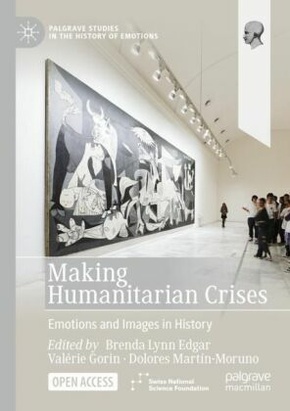
Making Humanitarian Crises - Emotions and Images in History
| Verlag | Springer |
| Auflage | 2022 |
| Seiten | 305 |
| Format | 23,5 cm |
| Gewicht | 266 g |
| Artikeltyp | Englisches Buch |
| Reihe | Palgrave Studies in the History of Emotions |
| ISBN-10 | 303100826X |
| EAN | 9783031008269 |
| Bestell-Nr | 03100826A |
This open access book explores the emotional agency of images in the construction of 'humanitarian crises' from the nineteenth century to the present. Using the prism of the histories of emotions and the senses, the chapters examine the pivotal role images have in shaping cultural, social and political reactions to the suffering of others and to the establishment of the international networks of solidarity. Questioning certain emotions assumed to underlie humanitarianism such as sympathy, empathy and compassion, they demonstrate how the experience of such emotions has shifted over time. Understanding images as emotional objects, contributors from a wide horizon of disciplines explore how their production, circulation and reception has been crucial to the perception of humanitarian crises in a long-term historical perspective.
Inhaltsverzeichnis:
Chapter 1. Crisis? What Crisis? Making Humanitarian Crises Visible in the History of Emotions; Dolores Martín-Moruno.- Chapter 2. 'Especial Outrage to Humanity and Civilisation.' The Atrocities of General Juan Manuel de Rosas and the Pursuit of Empathy; Moisés Prieto.- Chapter 3. Projecting Guilt and Shame in Wartime: How British State and Philanthropy Lectured on the Benefits of Retraining Schemes for Disabled Veteran Workers, 1914-1919; Jason Bate.- Chapter 4. The Touch of the Image: Affect and Materiality in Photojournalism of the Spanish Civil War; Jo Labanyi.- Chapter 5. Archiving the Trauma of Internment Camps in Film: Jacqueline Veuve's Journal de Rivesaltes, 1941-1942, (1997); Brenda Lynn Edgar.- Chapter 6. Empathy, Irony and Humanitarian Witness in The Photographer; Ariela Freedman.- Chapter 7. From Empathy to Shame: The Use of Virtual Reality by Humanitarian Organisations; Valérie Gorin.- Chapter 8. Afterword: Humanitarian Visual Practices: Emotions, Experience; Brenda L ynn Edgar and Valérie Gorin.
